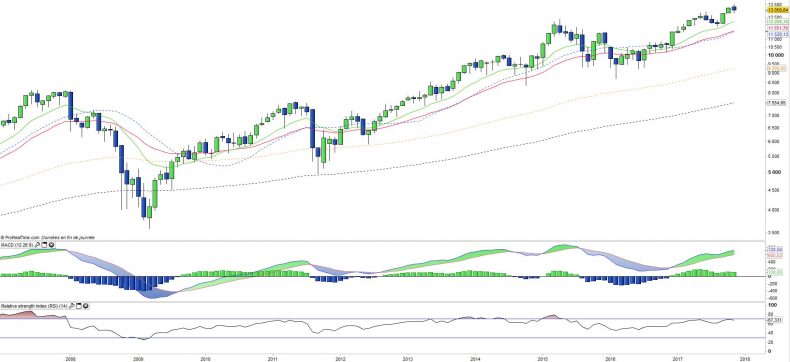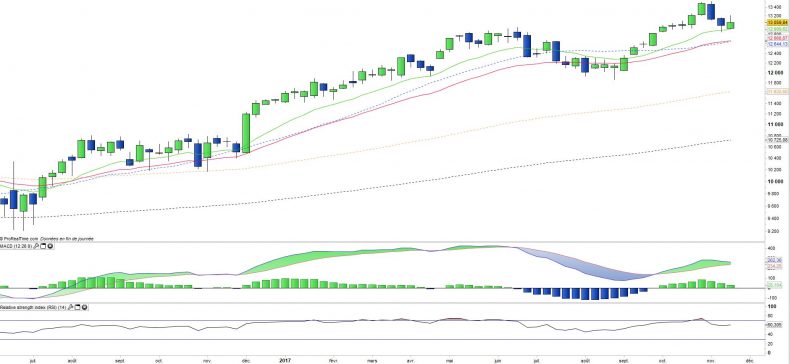Lyxor ETF DAX 30 (DAX) - 27/11/2017
Short term strategy : Positive (80%) / Trend -
Long term strategy : Positive (100%) / Trend =
Characteristics of the ETF
The DAX ETF (Lyxor), listed in Euro, replicates the DAX 30 index which is composed of the 30 main German securities representative of the main sectors, while the stocks are selected according to the size of their market capitalization.
The costs of this ETF are moderate at 0.15% and AUM are quite high at around € 1 204m. The replication method is direct (Physical) and the distribution of dividends is done by capitalization.
Alternative ETFs: CG1 (Amundi Euro), EWG (iShares USD)
Index & components
The top 10 stocks are mainly large industrial stocks such as Siemens or Bayer, while there are only 2 financial stocks: Allianz and Deutsche Post, the German master index is relatively narrow and mostly composed of large companies, essentially industrial groups. Unlike the English, French or Italian indices, the DAX is also distinguished by the absence of large oil companies that weigh heavily in the weighting of the CAC40, FTSE100 or FTSEMIB40, which is double-edged according to the specific cycle of the energy sector. Moreover, financials only weigh 17% of the index, half for the insurance giant Allianz, so the banking sector has a low weighting due to the well-known weakness of Deutsche Bank and Commerzbank. Conversely, the automotive and chemical sectors are more represented than in other European indices while the technology sector is essentially represented by SAP.
In summary, the DAX is a rather strong index from a sectoral point of view which can make it evolve differently from other European indices.
German fundamentals are very solid (GDP growth around 2%, historically low unemployment rate at less than 6% and accelerated deleveraging up to 2020). The main risks concern Germany's main customers, namely the United Kingdom, which could start to suffer from Brexit, the US in political uncertainty and threatening it with a trade war, Russia which remains a difficult and aggressive neighbor and China because of its business practices.
Latest developments
After an increase of 6.9% in 2016, the DAX30 has risen by 13.8% since the beginning of the year, significantly more than the stoxx600 (+ 9.8%) and is not far from its historical highs.
The German economy is doing well and its main European partners (France and Italy) are getting better and better, the Markit index of purchasing managers, which measures activity in the private sector, points to a further acceleration of growth in November for the euro area which is at its highest since the beginning of 2011. In Germany, the Composite PMI Composite Markit came out in November at 57.6, the highest in two months.
However, Germany is currently facing an unusual political uncertainty since its failure to form a coalition government with the Liberals and Greens. A new attempt should be made with the SPD in the coming weeks, without assurance of success while the latter came out weakened by his participation in the government and would have prefered to join the opposition. But new elections do not seem to be the solution to unlock the situation.
A risky period for Germany, even though traditionally party responsibility is at the center of the German consensus and should prevail.
Monthly data
The monthly chart shows an undeniably positive long-term trend in the midst of a new bullish wave. This trend is confirmed by the MACD and RSI which are in the high zone but not yet at the 2015 summit level and continue on an ascending path. No signs of a correction are noticeable at this point, and the November candlestick pauses without being too much corrective despite the bad news on the political front, which shows the strength of the current bullish movement.
Weekly data
On the weekly chart, we can notice that the short-term correction - 2 weeks - just stopped on the EMA13 level and a rebound begins to take place. The next week will decide the eventual end of correction or its deepening, a hypothesis that seems less likely.
Oscillators are already turning upwards without having gone through a negative cross, which is a favorable factor for the recovery of the underlying trend.
ETF Objective
DAX is a UCITS compliant ETF that aims to track the benchmark index DAX (30 companies)
Caracteristics
| Inception date | 01/06/2006 |
| Expense ratio | 0,15% |
| Issuer | Lyxor |
| Benchmark | Indice DAX 30 |
| Code/Ticker | DAX |
| ISIN | LU0252633754 |
| UCITS | Yes |
| EU-SD Status | Out of Scope |
| Currency | € |
| Exchange | Euronext Paris |
| Assets Under Management | 1 204 M€ |
| Replication Method | Direct (Physical) |
| PEA (France) | Yes |
| SRD (France) | Yes |
| Dividend | Capitalization |
| Currency Risk | No |
| Number of Holdings | 30 |
| Risk | 3/5 |
Country Breakdown
| Germany | 100% |
Sector Breakdown
| Consumer Discretionary | 18% |
| Financials | 17% |
| Health Care | 14% |
| Industrials | 14% |
| Materials | 14% |
| Information Technology | 12% |
| Telecom Services | 5% |
| Others | 8% |
Top Ten Holdings
| Siemens | 9% |
| Bayer | 9% |
| SAP | 9% |
| BASF | 8% |
| Allianz | 8% |
| Daimler | 7% |
| Deutsche Telekom | 5% |
| Deutsche Post | 4% |
| Linde | 3% |
| Adidas | 3% |


